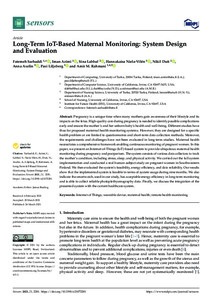Long-Term IoT-Based Maternal Monitoring: System Design and Evaluation
Sarhaddi Fatemeh; Azimi Iman; Labbaf Sina; Niela-Vilén Hannakaisa; Dutt Nikil; Axelin Anna; Liljeberg Pasi; Rahmani Amir M
Long-Term IoT-Based Maternal Monitoring: System Design and Evaluation
Sarhaddi Fatemeh
Azimi Iman
Labbaf Sina
Niela-Vilén Hannakaisa
Dutt Nikil
Axelin Anna
Liljeberg Pasi
Rahmani Amir M
MDPI
Julkaisun pysyvä osoite on:
https://urn.fi/URN:NBN:fi-fe2021093049010
https://urn.fi/URN:NBN:fi-fe2021093049010
Tiivistelmä
Pregnancy is a unique time when many mothers gain awareness of their lifestyle and its impacts on the fetus. High-quality care during pregnancy is needed to identify possible complications early and ensure the mother's and her unborn baby's health and well-being. Different studies have thus far proposed maternal health monitoring systems. However, they are designed for a specific health problem or are limited to questionnaires and short-term data collection methods. Moreover, the requirements and challenges have not been evaluated in long-term studies. Maternal health necessitates a comprehensive framework enabling continuous monitoring of pregnant women. In this paper, we present an Internet-of-Things (IoT)-based system to provide ubiquitous maternal health monitoring during pregnancy and postpartum. The system consists of various data collectors to track the mother's condition, including stress, sleep, and physical activity. We carried out the full system implementation and conducted a real human subject study on pregnant women in Southwestern Finland. We then evaluated the system's feasibility, energy efficiency, and data reliability. Our results show that the implemented system is feasible in terms of system usage during nine months. We also indicate the smartwatch, used in our study, has acceptable energy efficiency in long-term monitoring and is able to collect reliable photoplethysmography data. Finally, we discuss the integration of the presented system with the current healthcare system.
Kokoelmat
- Rinnakkaistallenteet [27094]
